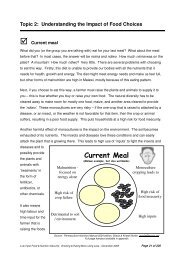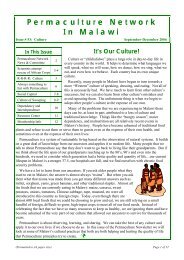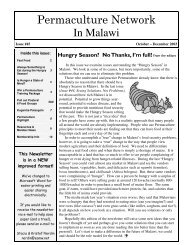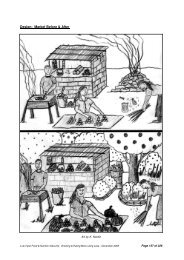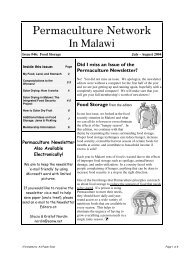Permaculture, Final Capstone Paper 5-26, Hope - Never Ending Food
Permaculture, Final Capstone Paper 5-26, Hope - Never Ending Food
Permaculture, Final Capstone Paper 5-26, Hope - Never Ending Food
You also want an ePaper? Increase the reach of your titles
YUMPU automatically turns print PDFs into web optimized ePapers that Google loves.
There are a few practices that a majority of participants employ. Practices that over 50%<br />
of both adopters and non-adopters employ include:<br />
• planting trees for soil conservation<br />
• no burning of organic matter<br />
• inclusion of localized and indigenous plants in food production zones<br />
Also of interest is that nearly 46% (6) of non-adopters included leguminous plants in their food<br />
production zones during the most recent growing season (2006-2007). None of these more<br />
commonly used practices are specific to <strong>Permaculture</strong>. Tree planting, incorporation of<br />
leguminous plants, and no-burn agriculture have been promoted by other development<br />
initiatives/organizations. For example, deforestation has been cited as a major barrier to<br />
development as far back as the 1930’s when the colonial government completed a series of<br />
surveys on Nyasaland (Berry & Petty, 1992). Since then, in both the colonial and independent<br />
governments, reforestation has been well supported at the policy, extension, and research levels.<br />
In fact, Malawi has the largest man made forest in Africa. It is important to note that while this<br />
assessment calculated the number of participants who have planted trees for soil conservation<br />
reasons, it did not measure the extent to which they have adopted this practice. Additionally, no<br />
respondent indicated having planted a woodlot, as <strong>Permaculture</strong> theory suggests.<br />
Roughly 70% of participants indicated growing indigenous or localized plants. The<br />
design of this inquiry did not include a methodical categorization of such food plants, but rather<br />
used a quick recall by participants to gain an understanding of what indigenous and localized<br />
participants are intentionally cultivating.<br />
39



